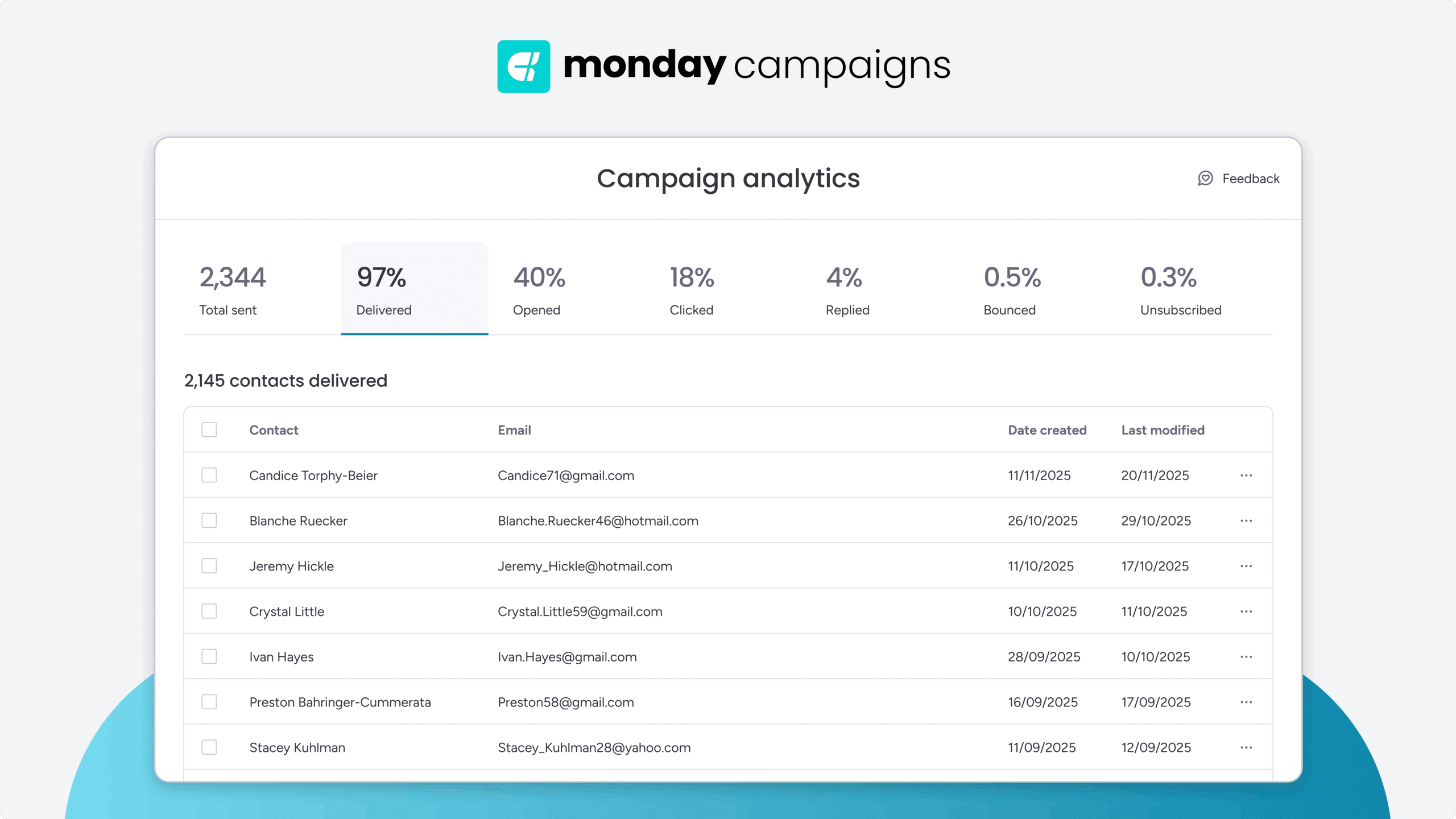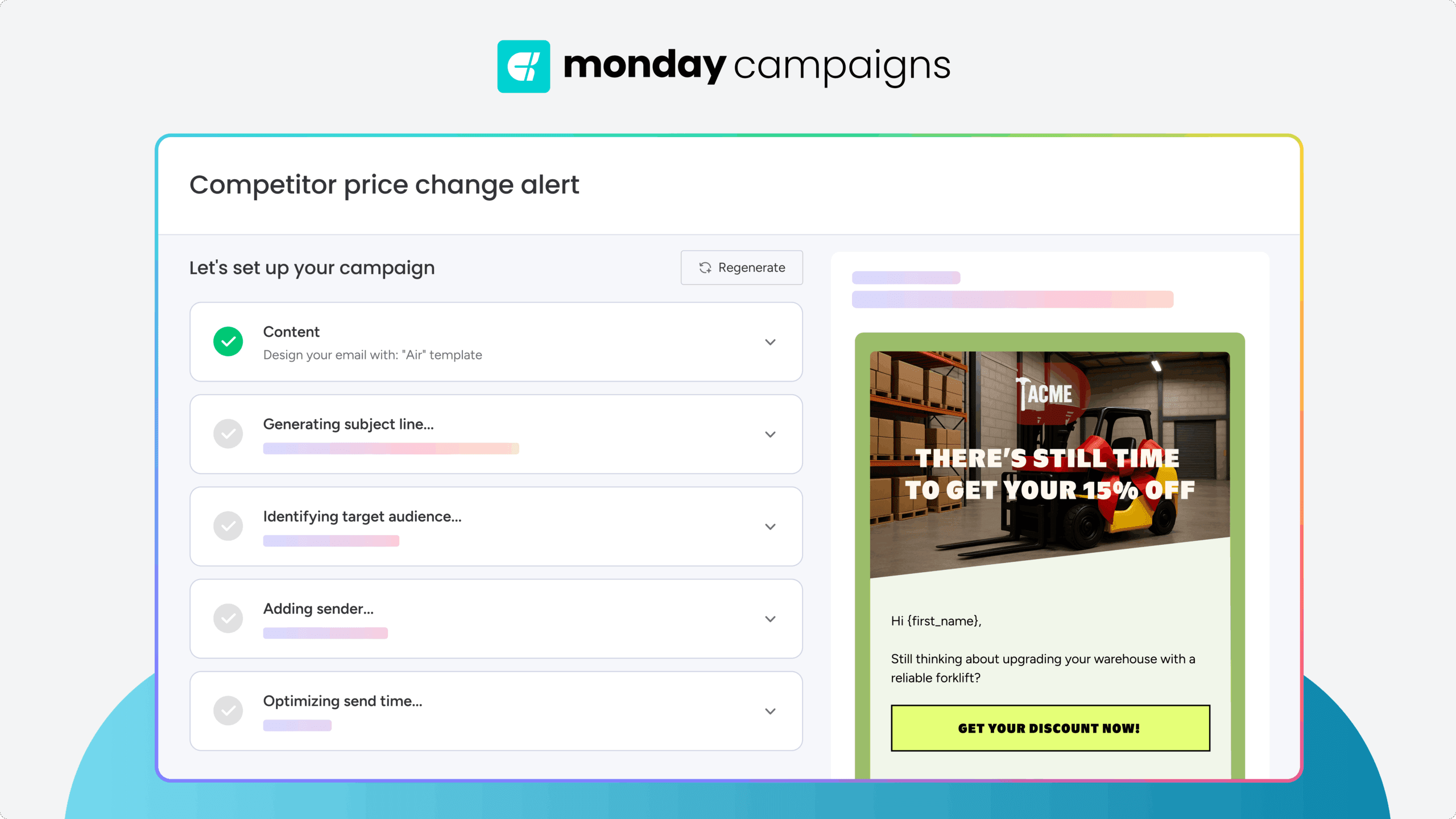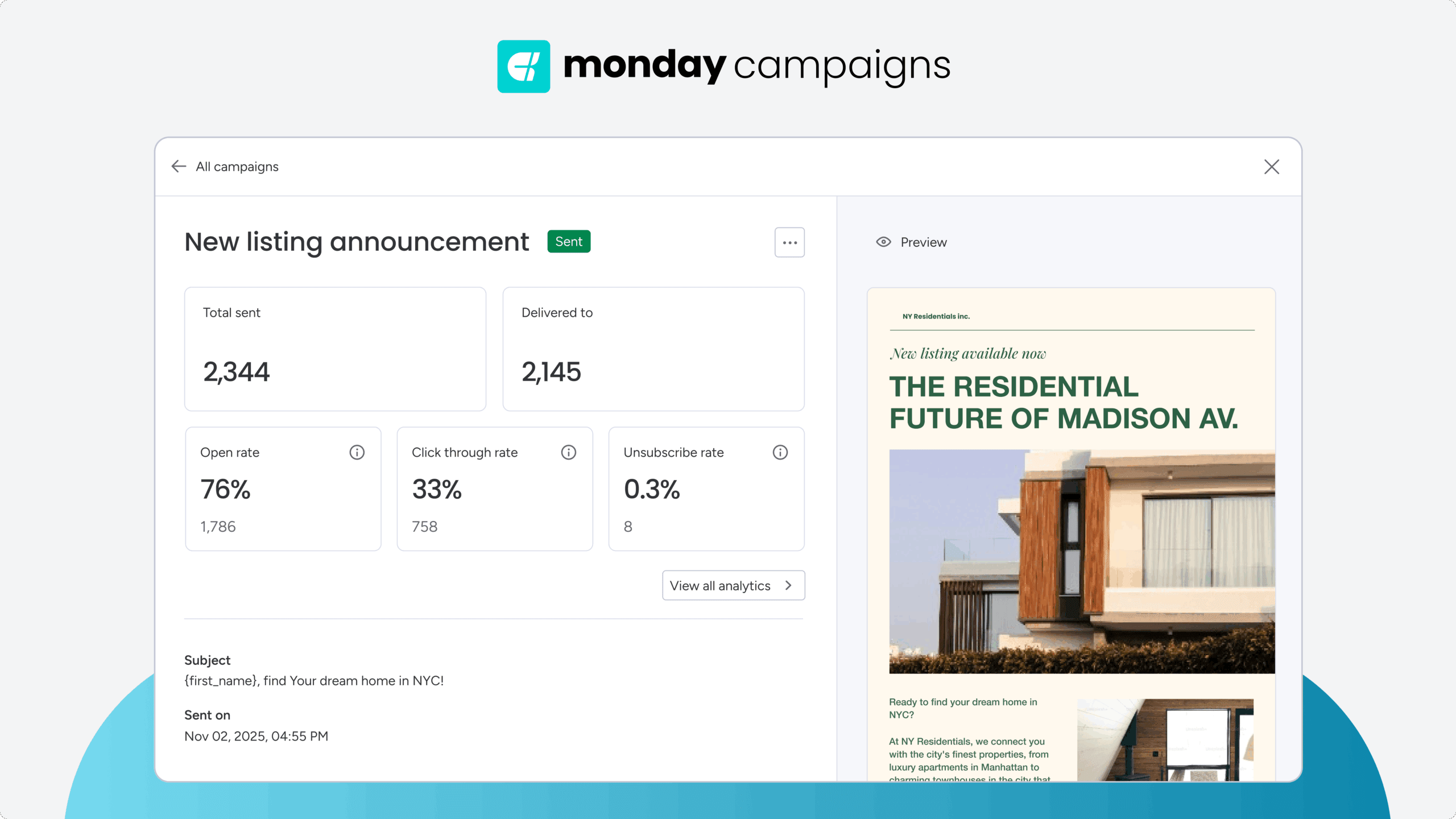Many marketing teams believe collecting customer feedback is the goal. But insights often sit in a spreadsheet, disconnected from the teams that can use them. The real value is not in asking for feedback. It is in turning that feedback into action that customers can see and feel. This is where a customer feedback loop makes the difference. It is a system for not just collecting input, but analyzing it, acting on it, and closing the loop with customers to show you listened.
This guide walks through the 4 stages of building an effective feedback system, from collecting data to measuring impact. We will explore the business benefits, best practices for success, and how AI-powered platforms can help you turn customer intelligence into optimized campaigns that deliver results.
Try monday campaignsKey takeaways
- Customer feedback loops turn input into visible action by building trust, retention, and revenue.
- Focus on 2–3 feedback channels your customers already use, like email, in-app prompts, or phone interviews.
- Respond within 48 hours to show customers their input matters and encourage more participation.
- Use AI to analyze feedback at scale, spot trends, and prioritize high-impact improvements.
- Turn insights into automated, revenue-driving campaigns with AI-powered tools like monday campaigns.
What is a customer feedback loop and why does it matter
A customer feedback loop is a continuous process where you collect customer input, analyze it, make improvements, and tell customers what changed. This creates an ongoing cycle that strengthens customer relationships and drives growth. In fact, Forrester’s US Customer Experience Index research shows that “customer-obsessed” companies see 41% faster revenue growth and significantly higher customer retention.
Think of it as a conversation that never ends. You ask customers what they think, listen to their answers, make changes based on their input, and then show them you heard them. This builds trust and encourages more feedback.
The feedback loop process explained
The feedback loop moves through 4 connected stages. First, you collect input through surveys, support tickets, or social conversations. Next, you perform customer feedback analysis to spot patterns. Then you implement changes. Finally, you close the loop by telling customers what you did.
Here’s what makes each stage work:
- Collection: Gathering feedback from multiple touchpoints captures the full customer experience.
- Analysis: Find patterns in feedback reveals what matters most to customers.
- Action: Make specific changes shows you take feedback seriously.
- Communication: Tell customers what changed encourages future participation.
Key components every system needs
Building an effective feedback loop requires specific elements working together. Without the following pieces, feedback gets collected but never drives real change.
- Feedback collection channels (surveys, in-app prompts, support)
- Centralized data hub or CRM
- Customer data analysis tools for pattern detection
- Defined ownership and accountability
- Action tracking for changes made
- Communication plan to close the loop
- Metrics to measure impact
When you build a feedback loop that actually works, the benefits show up in your bottom line — not just your satisfaction scores.
5 business benefits of customer feedback loops
Customer feedback loops deliver measurable advantages that go beyond customer satisfaction scores. These benefits compound over time, creating competitive advantages your competitors can’t easily copy.
1. Boost customer retention and lifetime value
Feedback loops help you identify unhappy customers early and take corrective action before they churn. When people see their input leads to change, they’re more likely to stay — and spend more.
Research shows that SaaS companies with NRR above 100% grow nearly twice as fast as peers with lower retention. Across industries, the average retention rate is around 75%, making loyalty one of the hardest — and most valuable — growth drivers.
Does a 5% increase in retention = a 95% profit boost?
The popular claim that a 5% improvement in retention can raise profits by 25–95% dates back to research from the early 1990s, popularized by Harvard Business Review in 2014.
Although the general principle still holds — small retention gains can create outsized returns — newer data show the impact depends heavily on industry, pricing model, and customer lifetime value. Today’s benchmarks focus less on a single ratio and more on net revenue retention (NRR) and customer lifetime value (CLV), which better reflect the compounding effect of loyalty and upsells.
2. Drive product innovation with real insights
Customer feedback reveals what people actually want — not what you think they want. This guides product development based on real needs, reducing wasted effort on features nobody uses.
To optimize campaigns automatically, monday campaigns uses this principle with customer behavior analysis. The platform learns what resonates with different segments and suggests improvements that boost engagement.
3. Align marketing and sales teams
Feedback creates shared intelligence between teams. When marketing and sales both embrace customer orientation, they create more relevant campaigns and have more meaningful conversations.
This alignment improves conversion rates throughout the customer journey. Sales knows what prospects care about. Marketing creates content that addresses real concerns.
4. Reduce customer service costs
Identifying recurring issues through feedback lets you fix problems before they generate support tickets. This proactive approach reduces support volume, operational costs, and customer churn.
Prevention costs less than reaction. When you solve root causes, customers need less help, and your support team can focus on complex issues that require human attention.
5. Accelerate revenue growth
Satisfied customers become advocates who drive organic growth. They refer friends, leave positive reviews, and expand their own usage — all revenue drivers that cost nothing to acquire.
Feedback also informs pricing strategies and market expansion. You learn what customers value most and what they’ll pay for, reducing the risk of new initiatives.
Try monday campaignsThe 4-stage framework for building feedback loops
Building an effective feedback loop means collecting the right data, analyzing it properly, acting on what matters, and showing customers you listened. This 4-stage framework gives you a practical roadmap for turning scattered customer input into systematic improvements that drive measurable business results. Here’s a quick-look table followed by a more detailed look at each stage:
| Stage | Description | Example tools/actions |
|---|---|---|
| Collect | Gather input via surveys, interviews, and social media | Email surveys, in-app prompts |
| Analyze | Use AI to identify patterns and sentiment | monday campaigns, NLP tools |
| Act | Prioritize and implement improvements | Impact-effort matrix, sprint boards |
| Close the loop | Communicate back to customers | Personalized updates, release notes |
Stage 1: Collect multi-channel customer data
Different channels provide different insights. Email surveys capture thoughtful responses about overall experience. In-app prompts get immediate reactions to specific features. Phone interviews reveal deep insights about customer motivations.
Here’s when to use each channel:
- Email surveys: Post-purchase feedback, quarterly satisfaction checks
- In-app prompts: Feature-specific feedback, real-time reactions
- Phone interviews: Complex issues, high-value customer insights
- Social monitoring: Unsolicited opinions, brand sentiment
Stage 2: Analyze feedback with AI-powered platforms
Manual analysis can’t keep up with growing feedback volume. AI-powered platforms process thousands of responses instantly, finding patterns humans might miss.
Sentiment analysis tools categorize feedback as positive, negative, or neutral. Topic modeling groups similar themes together. Priority scoring helps you focus on high-impact issues first.
To analyze campaign performance and customer responses, monday campaigns leverages AI automatically identifies what works for different segments and optimizes future campaigns based on these insights.
Stage 3: Implement changes based on insights
Not all feedback requires immediate action. Use an impact-effort matrix to prioritize changes. High-impact, low-effort improvements should happen first to build momentum.
Track implementation carefully. Monitor relevant metrics before and after changes to ensure improvements address the underlying issues. Regular updates keep stakeholders informed and maintain momentum.
Stage 4: Close the loop and measure impact
Telling customers what changed based on their feedback completes the cycle. Specific communication about improvements works better than generic “we’re listening” messages.
Measure both quantitative and qualitative impact. Track satisfaction scores, retention rates, and revenue metrics. Also monitor sentiment changes and customer engagement levels to understand the full effect of your improvements.

How to set up your feedback system
Setting up your feedback system doesn’t require complex infrastructure or massive budgets. What it does require is thoughtful planning around 4 key areas: choosing the right channels, automating collection, building your response team, and defining success metrics. Get these fundamentals right, and you’ll have a system that scales with your business and delivers consistent insights without overwhelming your team.
Select the right mix of feedback channels
Choose channels based on your customers’ preferences and your team’s capacity. B2B companies might focus on email surveys and phone interviews. B2C businesses might prioritize in-app feedback and social monitoring.
Start with 2-3 channels that align with how customers already interact with you. You can add more channels once you’ve mastered the initial ones and proven the value of feedback-driven improvements.
Build automated collection workflows
Automation ensures consistent feedback collection without overwhelming your team. Set up triggers based on customer actions — purchase completion, feature usage, support ticket resolution.
Timing matters for response rates. Post-purchase surveys work best within 48 hours. Feature feedback should happen during active use. Relationship surveys need careful spacing to avoid fatigue.
Create your response team structure
Assign specific people to monitor each feedback channel. Set response time expectations — critical issues within hours, general feedback within days. Create escalation paths for urgent problems.
Cross-functional teams work best because customer issues rarely fit in one department. Include people from product, marketing, sales, and support to ensure comprehensive responses and coordinated action.
Establish success metrics and KPIs
Track metrics that show both process effectiveness and business impact. Response rates indicate whether your collection methods resonate. Resolution times show how quickly you address concerns.
Business metrics demonstrate real value:
- Retention rate changes: Shows if improvements keep customers longer
- Support ticket volume: Shows whether you’re preventing problems
- Revenue per customer: Measures expansion and upsell success
- Referral rates: Tracks advocacy and word-of-mouth growth
Understanding positive and negative feedback loops
Not all feedback carries the same weight or requires the same response. Positive feedback shows you what’s working and where your competitive advantages lie. Negative feedback reveals gaps and improvement opportunities. Understanding both types — and how they interact — helps you build a balanced strategy that preserves your strengths while addressing weaknesses. Here’s how to recognize and leverage each type effectively:
Recognizing positive feedback patterns
Positive feedback reveals your competitive advantages. Look for themes about what customers love most — these insights inform marketing messages and product positioning.
Happy customers often make great advocates. Identify satisfied users who might provide voice of the customer testimonials, case studies, or referrals.
Converting negative feedback into growth opportunities
Negative feedback highlights blind spots and improvement opportunities. Look for recurring themes that indicate systemic issues rather than one-off problems.
How you respond to negative feedback matters as much as the improvements you make. Customers who see their concerns addressed often become more loyal than those who never had problems.
The balance between both types
Use positive feedback to identify what to preserve during improvements. Negative feedback shows what needs fixing. Together, they create a complete improvement strategy.
Monitor sentiment trends over time. Shifts in the balance between positive and negative feedback signal changes in customer perception that require attention.
7 best practices for feedback loop success
With customer feedback loops, it’s more about what you do with the feedback than collecting more data. These 7 best practices separate systems that drive real business impact from those that just create busywork. They’re based on what actually works across thousands of companies, from startups to enterprises, and they’ll help you avoid the most common pitfalls that cause feedback programs to fail.
- Respond to all feedback within 48 hours: Quick responses show you value customer input. Even if you can’t solve their problem immediately, acknowledge receipt and set expectations for next steps.
- Personalize every customer interaction: Reference specific details from their feedback. Use their history and context to provide relevant responses. Generic replies suggest you’re not really listening.
- Use AI for pattern recognition: AI processes large volumes quickly, identifying trends humans might miss. Sentiment analysis prioritizes urgent issues. Topic modeling groups similar feedback for easier analysis.
- Share insights across all teams: Product teams need feature requests. Marketing needs customer language. Sales needs common objections. Regular cross-functional meetings ensure everyone benefits from feedback insights.
- Track ROI at every stage: Measure retention improvements, support cost reductions, and revenue growth from feedback-driven changes. This data justifies continued investment and guides resource allocation.
- Scale with automation: Automated routing, workflow triggers, and AI analysis handle routine tasks. This frees your team to focus on complex issues and strategic improvements.
- Continuously optimize your process: Analyze feedback about your feedback process. Test different collection methods, response formats, and follow-up procedures to find what works best.
Advanced platforms for modern feedback management
Modern feedback management requires sophisticated platforms that handle volume while providing actionable insights. These systems move beyond simple data collection to offer automated analysis, predictive capabilities, and real-time dashboards that give every team the information they need.
AI-powered sentiment analysis
Sentiment analysis understands customer emotions automatically. Advanced systems identify specific feelings like frustration or excitement, not just positive or negative.
Real-time monitoring alerts you to sudden sentiment changes. This early warning system helps prevent small issues from becoming major problems.
Predictive analytics for proactive engagement
Predictive models identify at-risk customers before they complain or leave. They also spot upsell opportunities based on positive feedback patterns and usage data.
These insights enable targeted interventions that improve retention and growth. You can address problems before customers even report them.
Real-time dashboard solutions
Dashboards provide instant visibility into feedback trends and response performance. Executive views show high-level metrics. Operational dashboards track daily activities.
Customizable views ensure each team member sees relevant information without unnecessary complexity. This focused approach improves decision-making speed.
Integration capabilities with CRM systems
Feedback integrated with CRM creates complete customer profiles. Every interaction includes context from previous feedback, purchases, and support history.
With monday campaigns, you can connect feedback directly to customer records. This integration enables personalized campaigns based on individual preferences and past interactions, turning insights into targeted action.
Try monday campaignsTransform feedback into revenue with monday campaigns
As part of the broader monday CRM ecosystem, monday campaigns connects directly to your customer data, sales pipeline, and support interactions, creating a unified system where feedback doesn’t just sit in a spreadsheet, but actually drives the campaigns you send. This means every email, every segment, and every optimization is informed by real customer input flowing through your CRM.
The platform learns from how customers respond across every touchpoint in the monday ecosystem, automatically adjusting your marketing based on what’s actually working. It’s not just a campaign tool — it’s your feedback loop turned into a revenue engine.
Connect feedback directly to your CRM
Integration creates comprehensive customer profiles that inform every interaction. Feedback becomes part of the permanent record, providing context for sales, support, and marketing activities.
Automated synchronization ensures insights are immediately available across teams. This prevents conflicting messages and enables coordinated responses to customer needs.
Launch AI-optimized campaigns in minutes

AI analyzes feedback patterns to create targeted campaigns for specific segments. Dynamic content adjusts based on individual preferences and past responses.
Automated testing identifies the most effective approaches for different customer groups. Campaigns improve continuously without manual intervention.
Track impact from insight to sale

Comprehensive tracking connects feedback to revenue outcomes. See how improvements influence purchasing decisions and customer lifetime value.
Attribution modeling shows which feedback sources drive the most valuable improvements. This guides future investment in feedback collection and analysis.
Turn customer feedback into your competitive advantage
Customer feedback loops aren’t just about collecting opinions — they’re about building a system that turns insights into action, action into improvements, and improvements into revenue. The companies that win are the ones that close the loop: they listen, they act, and they show customers what changed.
Smart software like monday campaigns makes this process automatic. Connect feedback directly to your CRM, launch AI-optimized campaigns based on real customer insights, and track how improvements drive retention and growth. No more spreadsheets. No more disconnected data. Just a continuous cycle of learning and improving that your customers can actually see and feel.
Ready to transform scattered feedback into systematic growth? Start building feedback loops that actually drive results.
Try monday campaignsFAQs
How do you measure ROI from customer feedback loops?
Measuring ROI from customer feedback loops involves tracking customer retention rate improvements, support cost reductions, and revenue growth from feedback-driven changes. Compare these benefits against system and labor costs to calculate return.
What is the ideal response time for customer feedback?
The ideal response time for customer feedback is within 48 hours for acknowledgment, with urgent issues addressed immediately. Quick responses show respect for customer time and encourage future feedback participation.
How many feedback channels should a business use?
When deciding how many feedback channels to use, a business should start with 2-3 channels that match their customer preferences and team capacity. Add more channels only after mastering initial ones and proving value from feedback improvements.
Can customer feedback loops work for enterprise companies?
Customer feedback loops scale effectively for enterprise companies using automation and AI to manage high volumes. Enterprise implementations require sophisticated systems but deliver proportionally greater business impact.
How do you prioritize feedback when you receive too much?
Prioritize feedback using an impact-effort matrix that considers potential business value and implementation difficulty. Focus first on high-impact, low-effort improvements while tracking recurring themes for systematic issues.
What role does AI play in modern feedback analysis?
AI automates pattern recognition, sentiment analysis, and feedback routing to handle large volumes efficiently. Modern AI identifies trends, prioritizes responses, and suggests improvements that manual analysis might miss.
 Get started
Get started 

